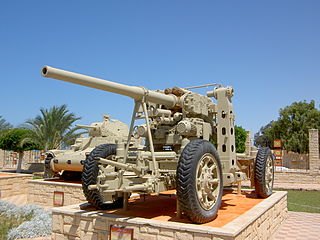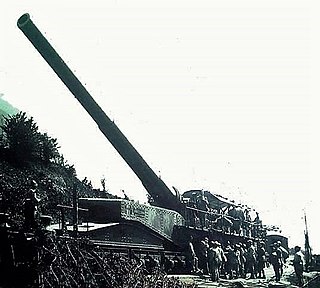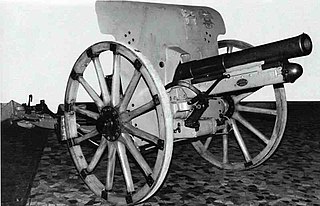
The cannone da 65/17 modello 13 was an artillery piece developed by Italy for use with its mountain and infantry units. The designation means 65 mm calibre gun, barrel length 17 calibres, which entered service in 1913. The designation is often shortened to cannone da 65/17.

The Cannone da 75/27 modello 11 was a French-designed field gun produced in Italy prior to World War I. It was introduced in 1912, designed by Joseph-Albert Deport. It was taken into service by Italy for use with its Alpine and cavalry troops going into World War I, and was built there in large numbers. The gun was designed with two notable features. It was the first artillery piece to introduce the split trail, as well as the last to utilize its novel dual-recoil system. The former became a very popular feature on artillery pieces through to the modern day. The later, while functional, did not get repeated. The dual-recoil system consisted of a small tubular recoil under the barrel which in turn traveled in a traditional rectangular cradle. This lessened heat transfer from the gun barrel to the recoil mechanism effectively, but was not necessary for the added complexity.

The Cannone da 90/53 was an Italian-designed cannon used both in an anti-aircraft role and as an anti-tank gun during World War II. It was one of the most successful anti-aircraft guns to see service during the conflict. The naval version of the gun was mounted on Italian battleships of the Littorio-class and the Andrea Doria-class.

The Canon de 105 mle 1913 Schneider was a French artillery piece used in World War I and World War II by many European countries.

The Breda 20/65 mod.35, also simply known as 20 mm Breda or Breda Model 35, among other variations, was an Italian 20 mm (0.787 in) anti-aircraft gun produced by the Società Italiana Ernesto Breda of Brescia company during the 1930s and early 1940s. It saw heavy usage during the Spanish Civil War and World War II, among other conflicts. It was designed in 1932 and adopted by the Italian armed forces in 1935, becoming one of two major 20 mm caliber anti-aircraft guns used by Italy during World War II, along with the Scotti-Isotta Fraschini 20/70, both of which fired the Swiss 20x138mmB "Solothurn Long" cartridge.

The 8 cm Feldkanone M.5 was a field gun used by Austria-Hungary during World War I. It was a conventional design, with its most notable feature being its obsolescent autofrettaged bronze barrel, necessary because Austria-Hungary still had trouble making steel of the proper quality.

The Cannone da 70/15 was a mountain gun was used by Italy during World War I. By World War II it had been relegated to the infantry gun role in units assigned to Italian East Africa.

The 15 cm Autokanone M. 15/16 was a heavy field gun used by Austria-Hungary in World War I. Guns turned over to Italy as reparations after World War I were taken into Italian service as the Cannone da 152/37. Austrian and Czech guns were taken into Wehrmacht service after the Anschluss and the occupation of Czechoslovakia as the 15.2 cm K 15/16(t). Italian guns captured after the surrender of Italy in 1943 were known by the Wehrmacht as the 15.2 cm K 410(i). Due to their unique ammunition, the Germans did not use them that much, and generally served on coast-defense duties during World War II.

The 10.4 cm Feldkanone M. 15 was a heavy field gun used by Austria-Hungary in World War I. It was derived from the successful 15 cm schwere Feldhaubitze M 14 modified to fire high-velocity 104-mm projectiles.

The Cannone da 149/40 was a heavy gun which served with Italy during World War II. It was intended to replace the obsolete Cannone da 149/35 A, but the small numbers produced prevented that. By 1940 orders had been placed for 590, but only 51 were in service at the end of September 1941. Weapons captured by the Germans after the Italian surrender in 1943 were put into service as the 15 cm K 408(i). Ansaldo produced a batch of twelve for the Germans in April 1944.

The Cannone da 75/27 modello 06 was a field gun used by Italy during World War I and World War II. It was a license-built copy of the Krupp Kanone M 1906 gun. It had seats for two crewmen attached to the gunshield as was common practice for the period. Captured weapons were designated by the Wehrmacht during World War II as the 7.5 cm Feldkanone 237(i).

The Cannon 102/35 Model 1914 was a naval gun of the Royal Italian Navy in World War I and World War II, which was modified for shore based anti-aircraft, field artillery, railway gun and coastal artillery roles.

The Cannon 76/40 Model 1916 was a widely used naval gun on ships of the Royal Italian Navy during World War I and World War II. A very versatile weapon it was used as primary, secondary and tertiary armament on a number of ship classes, while other ship classes had a shortened version of it, the Cannon 76/30 Model 1915. After being replaced aboard ships of the Royal Italian Navy it saw widespread use on land in a number of different roles such as coastal artillery, anti-aircraft gun and railroad gun during World War II.
The Cannone da 76/45 S 1911 was a naval gun used by Italy during World War I and World War II. In addition to its naval role it was also employed in coastal artillery, railway gun and anti-aircraft roles.

The Canon de 19 C modèle 1870/93 was a French coastal defense gun designed and built before World War I that also saw action during World War II. A number of guns were also converted to railway guns during World War I in order to meet the need for heavy artillery and these were also used in World War II.

The Canon de 19 modèle 1870/93 TAZ was a railway gun designed and built early in the First World War. It also saw action during the Second World War.

The Cannone da 149 G later known as the Cannone da 149/23 was an Italian fortress gun and siege gun which served with Italy during the Italo-Turkish War and World War I. Captured guns may have been used by Austria-Hungary.

The Cannone da 381/40 AVS was an Italian railway gun that saw action during World War I.

The Cannone da 75/27 modello 1912 cannon was a piece of horse artillery used by the Royal Italian Army during the First and Second World Wars. The Germans designated captured guns as the 7.5 cm Feldkanone 245(i).

The Cannone da 75/27 A.V. was an anti-aircraft gun developed in Italy during the First World War that also saw service during the Second World War.





















